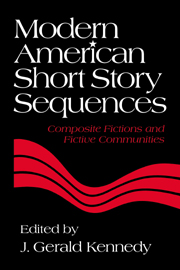Book contents
- Frontmatter
- Contents
- Contributors
- Introduction: The American Short Story Sequence – Definitions and Implications
- Henry James's Incipient Poetics of the Short Story Sequence: The Finer Grain (1910)
- Toomer's Cane as Narrative Sequence
- Hemingway's In Our Time: The Biography of a Book
- Wright Writing Reading: Narrative Strategies in Uncle Tom's Children
- The African-American Voice in Faulkner's Go Down, Moses
- Meditations on Nonpresence: Re-visioning the Short Story in Eudora Welty's The Wide Net
- Nine Stories: J. D. Salinger's Linked Mysteries
- Cheever's Shady Hill: A Suburban Sequence
- John Updike's Olinger Stories: New Light Among the Shadows
- Louise Erdrich's Love Medicine: Narrative Communities and the Short Story Sequence
- From Anderson's Winesburg to Carver's Cathedral: The Short Story Sequence and the Semblance of Community
- Index
Hemingway's In Our Time: The Biography of a Book
Published online by Cambridge University Press: 29 September 2009
- Frontmatter
- Contents
- Contributors
- Introduction: The American Short Story Sequence – Definitions and Implications
- Henry James's Incipient Poetics of the Short Story Sequence: The Finer Grain (1910)
- Toomer's Cane as Narrative Sequence
- Hemingway's In Our Time: The Biography of a Book
- Wright Writing Reading: Narrative Strategies in Uncle Tom's Children
- The African-American Voice in Faulkner's Go Down, Moses
- Meditations on Nonpresence: Re-visioning the Short Story in Eudora Welty's The Wide Net
- Nine Stories: J. D. Salinger's Linked Mysteries
- Cheever's Shady Hill: A Suburban Sequence
- John Updike's Olinger Stories: New Light Among the Shadows
- Louise Erdrich's Love Medicine: Narrative Communities and the Short Story Sequence
- From Anderson's Winesburg to Carver's Cathedral: The Short Story Sequence and the Semblance of Community
- Index
Summary
If you were not there at the time, Hemingway insisted, you could not possibly understand how things happened. He might have added that if you were there, you might be equally confused but in a different way. Of all the books in the Hemingway canon, none is more confusing than In Our Time, confusing now and then, confusing to reader and author, and particularly confusing to its bibliographers. It will remain that way forever, for its several parts – biographical, literary, editorial, and bibliographical – contain so many contradictions that any analysis will be flawed. Perhaps it is better that way, for so long as enigmas remain, the book lives; despite our proclaimed rage for order, there remains something about confusion that particularly delights us. Today the book and its attendant bibliography are a tangled ball of yarn. No matter which piece one selects to unravel first, the reader finds it snarled with another, and the unraveling becomes merely a rearrangement of the tangle.
As an entry point, we might note that Hemingway published three volumes of short stories: In Our Time (1925), Men Without Women (1927), and Winner Take Nothing (1933). Although all three titles imply a governing concept, only In Our Time has provoked numerous and divergent readings as a crafted sequence of stories with a sum larger than its parts. Neither the second nor the third volume evolved quite as complexly as did In Our Time, nor did Hemingway make any organizational claims for either of these volumes as he did for his first collection.
- Type
- Chapter
- Information
- Modern American Short Story SequencesComposite Fictions and Fictive Communities, pp. 35 - 51Publisher: Cambridge University PressPrint publication year: 1995
- 1
- Cited by



